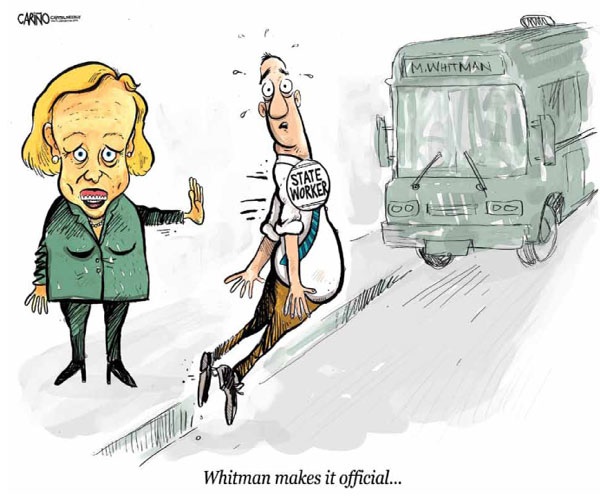By Ed Mendel
The Highway Patrol union that negotiated the most generous pension formula a decade ago, a trendsetter for police and firefighters statewide, has tentatively agreed to reduce pensions for new hires.
The “three at 50” formula, providing 3 percent of final pay for each year served at age 50, became the best-known part of a sweeping state worker pension increase, SB 400 in 1999, often cited by critics who say public pension costs are “unsustainable.”
Gov. Arnold Schwarzenegger, applauding the Highway Patrol agreement last week, said once again in a news release that rolling back the benefit increase in SB 400 is one of the demands that must be met before he signs a new state budget.
“I am absolutely committed to getting pension reform done because we cannot continue down this unsustainable path that has taxpayers on the hook for $500 billion in debt,” the governor said.
New Highway Patrol hires would get a “three at 55” pension formula, if the bargaining agreement is approved by Highway Patrol members and then enacted by legislation.
That’s a significant cut. But it’s still more generous than the pre-SB 400 Highway Patrol formula, “two at 50,” which provided 2.7 percent of final pay for each year served at age 55.
At a CalPERS forum in January, the chief executive of the California Association of Highway Patrolmen, Jon Hamm, said he might negotiate lower pension benefits for new hires. Pensions promised current workers are regarded as contracts that can’t be cut.
“I have come to the conclusion it’s a very strong likelihood I would be looking out for future employees by negotiating a second-tier retirement system,” Hamm said. “The last thing we want to do is leave it to the initiative process.”
An attempt to put an initiative on the November ballot to reduce state and local public pension benefits and extend retirement ages failed for lack of funding. But the backers are talking about trying again if pension costs are not cut.
This time, however, the initiative might be a proposal to switch new hires from pensions to the 401(k)-style individual investment plans common in the private sector, a change that a poll last fall showed had strong support among voters.
A severe economic recession has sharply reduced tax revenue, forcing deep cuts in state and local government programs. Public pensions are the exception, moving into the spotlight by imposing or projecting big cost increases to replace investment losses.
A study of state pensions issued in February by the Pew Center on the States, grimly reporting a $1 trillion funding gap, said the good news is that a growing number of states are changing benefits and taking other “reform” action.
But in California, Schwarzenegger faces Democratic legislative leaders, traditional allies of labor, who say any cut in pension benefits must be done through labor negotiations, not imposed by legislation.
The tentative agreements announced last week, some including pay cuts, with four unions representing 23,000 patrolmen, firefighters, psychiatric technicians and others are projected to save the state $72 million in the new fiscal year beginning July 1.
That’s about 12 percent of the state workforce. If similar agreements were reached with eight other unions, said the governor’s news release, state savings next year would total $2.2 billion.
In addition to lower pensions for new hires, the four unions agreed to boost the pension contributions from current workers to 10 percent of pay, up from 5 to 8 percent contributed now depending on the union.
The powerful California Public Employees Retirement System board last week ordered an 18 percent increase in the employer contribution from the state in the fiscal year beginning next month. The new state rates range from 20 to 33 percent of pay.
The tentative agreements have an “anti-spiking” provision aimed at manipulations to boost pensions. Pay used to calculate pensions would be broadened from the final year to the last three years, a safeguard already in a number of state contracts.
Meanwhile, some local governments also are cutting pension costs this year. Action in at least 62 local government agencies ranges from considering proposals to completed contract amendments, the CalPERS board was told last week.
“There is no cookie-cutter approach,” said Pat Macht, the CalPERS public affairs director. She mentioned lower benefits for new hires, higher worker contributions, anti-spiking, extended retirement ages, and “golden handshakes” to encourage retirement.
The CalPERS report and tracking done for Dave Low, chairman of a public employee union coalition on retirement issues, show that some local governments are not following the Highway Patrol this time.
Rolling back police and firefighter pensions all the way to the pre-SB 400 formula, “2 at 50,” reportedly has been discussed by city managers in the San Francisco east bay and executives in a half dozen Sacramento area counties.
A decade ago, the Highway Patrol was a clear leader with the “three at 50” formula. Local governments are under pressure in labor talks to meet or exceed benefits offered by other agencies, a competition some say “ratchets up” pensions.
Data from the giant California Public Employees Retirement System, handling pensions for 1,568 local governments, shows that none of its plans were as generous as “three at 50” before SB 400, said an Assembly Republican report earlier this year.
Now 64.7 percent of local public safety plans in CalPERS have the Highway Patrol’s trendsetting “three at 50” formula, said the report, but about a third still have lower benefits.
Although SB 400 helped boost local public safety pensions, the report suggests that some of the motivation for the landmark legislation was that state worker pensions in the largest job classification, “miscellaneous,” trailed local government pensions.
“More plans that offer SB 400-level benefit formulas were adopted before the implementation of SB 400 (913 plans) than were adopted after (640 plans),” said the Assembly Republican report.
Now 99 percent of local plans have miscellaneous formulas equal or better than SB 400, up from 58 percent before the legislation.
Benefits for miscellaneous state workers were increased by SB 400 from “two at 60” to “two at 55.” The “two at 60,” still a little-used option, was a reduction enacted under former Gov. Pete Wilson in 1991.
SB 400 also took the unusual step of authorizing a retroactive increase in pension payments to retirees, ranging from 1 percent to persons who retired in 1997 to 6 percent to persons who retired in 1974 or earlier.
CalPERS told legislators that the benefit increases in SB 400 would be mainly paid for by investment earnings, resulting in little change in state costs for a decade. But the state payment to CalPERS, $150 million in 2000, is $3.9 billion in the new fiscal year.
Much of the dramatic increase is because CalPERS, with a surplus from a booming economy, gave the state a contribution “holiday” in 2000, dropping the state payment from $1.2 billion several years earlier.
As local government officials in some areas talk about area-wide agreements that could help “ratchet down” pension costs, would a reduction in Highway Patrol pensions cause the state prison guard union to do the same?
Probably not, but there is some irony.
The California Correctional Peace Officers Association has made perhaps the biggest gains among state worker unions of recent decades, often by negotiating pay and other benefits linked to the Highway Patrol.
But after personal attacks on Gov. Arnold Schwarzenegger, with portable billboards towed around the Capitol and other tactics, the union has worked with an expired contract since 2006 and may be waiting for a new governor next year.
Reporter Ed Mendel covered the Capitol in Sacramento for nearly three decades, most recently for the San Diego Union-Tribune. More stories are at http://calpensions.com/ Posted 23 Jun 10






























No comments:
Post a Comment